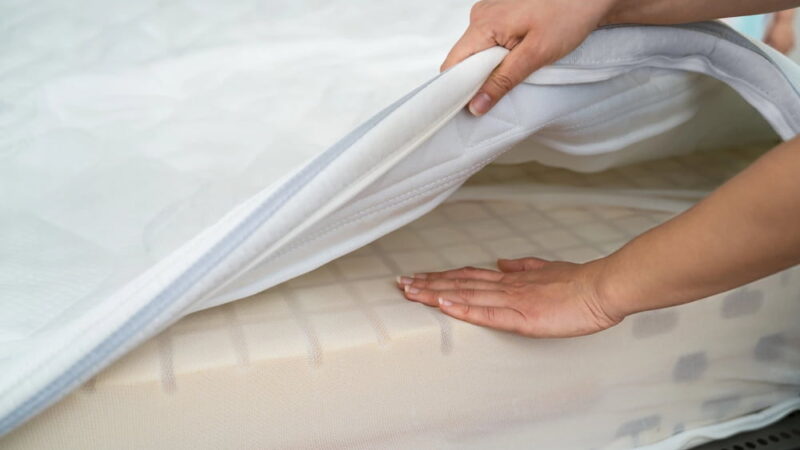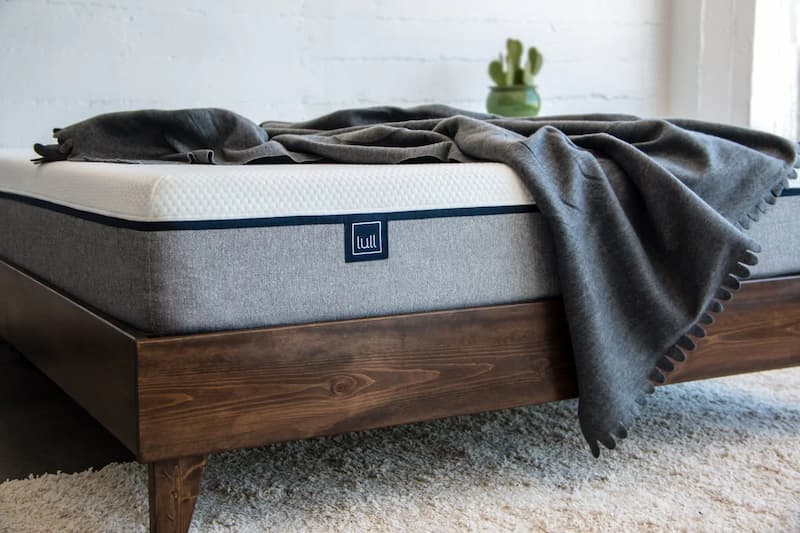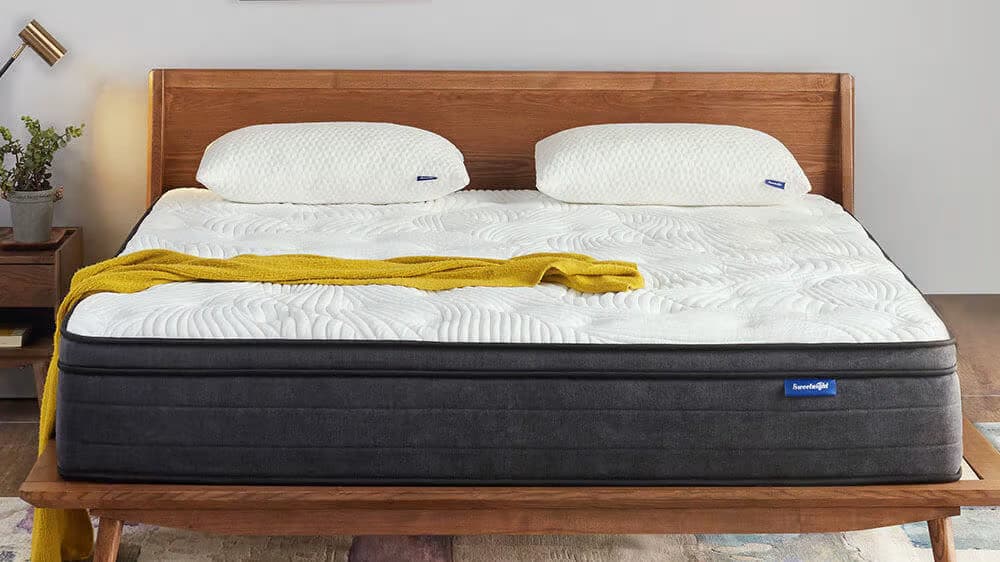How Long Do Memory Foam Mattresses Last? Already Solved

Like Hershey bars, memory foam mattresses are widely available. However, are they still as sweet?
Without a doubt, memory foam mattresses are incredibly popular when looking for mattresses.
You could infer something about their longevity from their popularity, but does that make sense?
How long do memory foam mattresses last? The typical mattress lifespan is 10 years, but this can vary depending on the material’s quality; some mattresses may last even longer.
Mattresses made of memory foam are not indestructible and eventually need to be replaced. In this section, we’ll delve a little deeper into the subject and give you some tips on how long your memory foam mattress will last.
Keep reading.
Table of Contents
What Is Memory Foam?
In order to give it viscoelastic properties, memory foam is made from polyurethane foam and chemical additives. The majority of memory foam is made with petrochemicals to give it its distinctive contouring feel, but some brands substitute some of the petrochemicals with plant-based oils to create a foam that is more environmentally friendly.
Under heat and pressure, memory foam stretches and contracts, conforming to the shape of the object pressing into its surface. If you picture a human body, the pressure and heat cause the foam to stretch, which causes it to shape and conform to the body’s curves.
The name “memory foam” stems from the foam’s ability to temporarily hold the shape of the object pressing into the foam. The shape of your hand, for instance, would continue to exist for a short period of time after you remove it from memory foam. It’s almost as though it holds the “memory” of your hand’s shape.
The more time that heat and pressure are applied, the more the foam conforms to the object. By staying in one position on the memory foam for a longer period of time, sleepers experience greater contouring. The foam changes shape when the sleeper moves, then takes its original form.
At pressure-point hotspots like the hips and shoulders, memory foam mattresses cradle the body and provide pressure relief. Nearly every part of the body, including sore or painful areas, experiences pressure reduction. No matter how the sleeper is positioned, its ability to conform to the body makes it incredibly helpful for maintaining spinal alignment. It can be found in typical memory foam mattresses, mixed-foam products, hybrids, and quilted mattress covers for innerspring mattresses.
Because it can keep the spine aligned even when the sleeper shifts position throughout the night, memory foam is popular among side sleepers. However, back and stomach sleepers can also find it comfortable when the firmness and layering are just right.
How Is Memory Foam Made?
Back in the 1970s, memory foam was hailed as an innovative mattress filling. Coil spring mattresses were the rage at the time, but then a soft memory foam mattress appeared that could provide less motion transfer and greater comfort than coil spring.
Memory foam mattresses are now available with cooling gels, cooling copper, and a variety of other bells and whistles thanks to advancements in the material.
Polyurethane, which is used to make memory foam mattresses, contains viscoelastic chemicals. In addition to helping the foam maintain its “memory,” these chemicals help the mattress retain heat. Because memory foam typically sleeps hot, it might not be ideal for everyone.
Does Memory Foam Degrade Over Time?
All good things must come to an end, just as day turns into night and spring into summer. Memory foam mattresses deteriorate for the same reasons that any other mattress deteriorates.
The caliber of the materials used in its construction, whether it has been kept clean and dust-free, how much weight it has supported, whether you have shared the bed with a partner or occasionally had children or pets on the bed, as well as how much weight it has been holding. The lifespan of a memory foam mattress depends on its construction and care.
Memory foam mattresses have viscoelastic chemicals that retain heat, making them uncomfortable for warm sleepers.
Memory foam might not be as supportive as some other mattress materials. On a memory foam mattress, side sleepers and stomach sleepers may both experience hip and lower back pain. The foam’s sinking characteristic and purported inability to support the delicate hip, shoulder, and back regions are the causes of this.
How To Ensure The Longevity For A Memory Foam Mattress?
When answering “how long do memory foam mattresses last?” we have to consider the care element. Imagine your memory foam mattress as a modern, feature-rich new car. You can get a lot of miles out of your car if you take it in for regular tune-ups and keep it clean. But if you treat the “Maintenance Required” lights on the dashboard as a suggestion, you might be parting ways sooner than the manufacturer intended.
A mattress is no different. How you take care of your mattress will determine how many long, dreamy years you have together. In which case, consider:
- Rotating it – By turning your mattress, you can more evenly distribute your weight across its surface. As a result, lumps won’t form or a mattress will not sag. Uncertain of the proper mattress rotation schedule? Every two or six months, rotate your mattress 180 degrees so your head will be where your feet used to be. Once more rotate it after a few more months.
- Using a mattress protector – An excellent mattress protector should be purchased as soon as you purchase a new mattress to protect it. Your mattress protector protects your brand-new mattress from stains, dirt, dust mites, and bacteria that could shorten its lifespan. To that end, our Waterproof Mattress Protector does a phenomenal job of keeping your mattress safe from stains, spills, and dirt while keeping you safe from potential irritants. Additionally, it can be machine washed, which makes cleaning your memory foam bed even simpler.
- Washing your bedding regularly – Only the bedding you use can determine how clean a mattress is. You can keep your mattress smelling fresh even as it nears the end of its useful life by routinely washing your sheets, blankets, and mattress cover. Do you need advice on how to clean a mattress? For information on cleaning a mattress, visit our blog.
- Using a strong frame – Your comfortable bed is supported by your mattress. However, what gives it support? Long term sagging, lumps, and bumps in a mattress can be avoided with a sturdy bed frame. You can find the ideal match for your memory foam mattress among the many different shapes and designs of our bed frames.
- Airing it out – On bright, dry days, let your foam layer mattress breathe. Give your mattress a few hours to air out after stripping off your bedding and turning on a ceiling fan, if you have one. In addition to drying out any excess moisture that your mattress may have absorbed while you slept, this will assist in preventing the development of odors. Moisture can lead to mold and bacteria, so giving your mattress some time to air out will benefit both you and your mattress in the long run,and can contribute to greater mattress longevity.
Are memory foam mattresses warm, and if so, is that a factor in the excess moisture in your mattress? How well your memory foam mattress performs will determine the answer.
How To Determine Mattress Durability And Lifespan?
One of the most long-lasting mattress types available is one made of memory foam. High-quality memory foams may last 10, 15, or even 20 years, whereas models with low-quality memory foam may start to lose their ability to bounce back or return to their original shape after only a few years.
The durability of the memory foam is influenced by a number of factors. Density comes first and foremost; however, we’ll also talk about layer thickness and the deflection of the load caused by indenting foam. Additionally, we’ll talk about how the mattress warranty can help you ensure that your brand-new bed will last.
Density
One of the simplest ways to assess the resilience and longevity of memory foam is through its density. In terms of memory foam, density is expressed in pounds per cubic foot (PCF).
- Low-density = <3.5 PCF
- Medium-density = 3.5 to 5 PCF
- High-density = >5 PCF
Memory foams with a low PCF degrade more quickly, whereas foams with a high PCF last longer. The density of a mattress as a whole, though, cannot be gauged from a single layer. Anywhere in the mattress that has a layer of low-density memory foam will make the mattress less dense and less durable. The general rule is that the mattress’s overall durability increases with the amount of high-density foams used in it. The higher production costs of high-density memory foams are offset by their longer lifespan.
When discussing density, it’s important to keep in mind that 1) density does not necessarily equate to firmness. 2) Memory foam naturally softens with time and use. A dense foam can be quite soft, whereas a less dense foam may be firm, although the opposite can also be true. However, despite any softening, high-density foams will continue to revert to their initial shape for a longer period of time than a low-density foam.
Indentation Load Deflection (ILD)
Depending on who is using the term, indentation load deflection (ILD) may also be referred to as indentation force deflection (IFD). Any term used to describe the ILD indicates how firm the foam is. A 50 square inch device compresses a 15 x 15 x 4-inch piece of foam to 25% of its original height as part of a standard test.
A firmer foam is indicated by a high ILD, whereas a softer foam is indicated by a low ILD. Foam density can be either high or low in a high ILD foam. Low ILD foams exhibit the same behavior. However, the ILD can inform you of what to anticipate in terms of the foam’s performance and feel. Because it requires more force to reduce foam to 25% of its original height, thicker layers will have a higher ILD.
What does ILD have to do with how long a mattress will last? Density has a greater impact on mattress longevity than firmness. But it’s a good idea to take note of each layer’s density and ILD to understand how the mattress will feel and how it will hold up to wear and tear over time.
Consider where the low- or high-ILD foams are positioned in relation to the layer densities. The mattress may break down and lose its desired firmness level more quickly if it has a low density, low ILD foam layer. It might not have as much of an impact on durability if there is a thin comfort layer followed by several thick, high-density layers.
Layer Thickness
The support core of a mattress is its thickest, densest, and firmest layer. This layer contributes significantly to the durability of the mattress as well as its shape. The durability of a thicker mattress isn’t always greater than that of a thinner one.
The density and firmness of each layer will affect both comfort and durability. Based on the density of each layer, two mattresses with the same height and layer thickness may have different lifespans. But if it is supported by thick, high-density transition and support layers, a single thin, low-density top layer might not matter as much in terms of durability. It’s important to consider the mattress as a whole and how it will support body weight over time, to reiterate.
Mattress Warranty
It makes sense for mattress producers to base their warranties on how long they anticipate their products will last. Ten years is the typical warranty period for mattresses. Manufacturers of mattresses who provide 15, 20, 25, and lifetime warranties design them to last much longer than the industry standard of 10 years.
The type of foundation and upkeep required to keep the bed in good condition are both covered by the warranty.
We understand how tough it might be to know how to clean a memory foam mattress, so we’re here to assist!
Typical Memory Foam Mattress Lifespan
A foam mattress has a six- to eight-year lifespan on average. High-quality, high-density memory foam models last a lot longer. There are memory foam models with warranties and lifespans of 15 to 20 years. These models are significantly above average thanks to the foams and material quality combination.
The lifespan also varies greatly depending on the type of mattress. Only natural latex mattresses consistently outperform memory foam in terms of longevity when compared to high-quality, high-density memory foam. A latex mattress has a twenty-year lifespan.
The average lifespan of a hybrid mattress is eight years, compared to the six to eight years of an innerspring mattress. In-depth information on the anticipated lifespans of the major mattress types can be found in our guide on how long a mattress lasts.
All of these figures are approximations. Longevity will also depend on your individual circumstances. For instance, heavier sleepers will experience shorter mattress life due to the additional wear and tear of more body weight.

How Does My Mattress Affect Foam Density And What Does It Mean?
It’s important to remember that mattresses made of memory foam with a lower density aren’t always a bad idea. For instance, a lower density mattress is ideal if you’re looking for a mattress for a guest bedroom that isn’t used frequently. For its intended use, the shorter lifespan is adequate, and you’ll also save some money.
Make sure you’re dealing with a reputable business that will disclose the density of their memory foam products and adheres to BS regulations before making a memory foam mattress purchase. Our memory foam densities are shown on the product pages, and all of our memory foam mattresses come with a 12-month guarantee, with many also including an extended warranty of up to 10 years. This demonstrates to you our faith in our goods and the superior components we use.
Be aware that there are companies out there that import low-cost foam mattresses from abroad that don’t adhere to British fire standards, use inferior materials, and deteriorate very quickly.
Tips To Increase The Average Lifespan Of A Mattress
A mattress has an average lifespan of 8 to 10 years, but if you treat it well, you can extend its life and keep it comfortable for longer, regardless of the material it is made of.
- Clean your mattress regularly, spot clean with a stain remover if necessary
- Vacuum the mattress every time you change the sheets
- When changing the sheets let the mattress breath for a while, open the window and allow some fresh air in to ventilate the room and your mattress
- Rotate or flip your mattress on occasion so you’re using every inch
- Use a mattress protector that will keep dust, dead skin cells, dog hair, saliva, and dust mites away from your mattress
- Use a mattress foundation to ensure mattress ventilation which could prolong the lifespan of your mattress while giving you storage space under your bed
How Frequently Should You Buy New Mattresses?
If you have a memory foam mattress, you may be wondering whether it degrades over time. Yes, you should be able to use your memory foam mattress for about 8 to 10 years. Your ability to get a good night’s sleep is not guaranteed for the duration of the mattress. You might experience sleeping on quicksand or find that it gets too hot too quickly.
When purchasing a new mattress, the quality of your sleep should be your top priority. Without a doubt, you desire pressure-relieving comfort that is long-lasting and comfortable. You need AirFoam, a breakthrough in mattress technology that could provide you with much more comfort than even the most expensive memory foam mattresses.
Compared to memory foam, AirFoam mattresses sleep much cooler because they are 100% temperature neutral. Compared to memory foam, they provide four times more pressure relief and are three times as durable.
Memory foam mattresses have served their purpose; by choosing a more contemporary mattress material, you can be sure that it was developed using the most up-to-date research, design, and manufacturing techniques. rather than relying on a material created in the 1970s, giving you the most modern sleep comfort available.
How To Tell When It’s Time For A New Memory Foam Mattress
As much as you may adore your memory foam mattress (especially if you purchased it from us), there are times when it’s best to look for the signs that it’s time to upgrade. Even a high-quality mattress has an upper age limit.
- Your mattress sags – One of the most obvious signs you require a new mattress is if the surface of your current mattress appears to have the imprint of a sleeping snow angel. If your mattress has dips or you-shaped pockets, it can no longer provide the support and pressure relief you require, which can lead to neck, shoulder, hip, or back pain.
- Your mattress is more than ten years old – For mattresses, age is a reliable indicator of when it’s time to start looking for a new bed. Age may be a state of mind for people. It’s time to let your old mattress retire after ten years of use and abuse, absorbing sweat, oil, skin cells, dirt, and grime, as well as perhaps a few jumping-on-the-bed sessions.
- You’ve noticed you’re having allergy or asthma flare-ups – Even with the best care, memory foam mattresses, like all other mattress types, can gather a lot of dust and dander over time. Unfortunately, this could adversely affect your ability to sleep, and you might start feeling runny or stuffy every morning. If so, your memory foam bed is prepared to join the large bedroom in the sky.
Memory Foam Mattress Price
Prices for memory foam mattresses range from $200 to more than $2,000, depending on quality. You’re looking at models with less dense foams at the entry level, between $200 and $700, because they are less expensive to produce. Although some of these models will be as comfortable as more expensive mattresses, their lifespans won’t be nearly as long. Others might not last the typical six years before sagging or indentations start to appear.
There is a large selection of mattresses that balance the quality of the materials with the price in the middle price range, from $700 to $1,200. These models have better durability because they use higher density foams throughout. The most comfortable mattresses may also include additional cooling components like gel, copper, or graphite to improve breathability.
Mattresses priced between $1,200 and $2,000 and even some that are almost $3,000 are available on the high end of the memory foam market. These models could include more layers with a range of firmnesses and densities to prolong the mattress’ life.
Frequently Asked Questions
How Do You Know When To Replace Your Mattress?
If your mattress is no longer providing you with a restful night’s sleep, that is the surest indication that you need to replace it. It’s possible that your back hurts when you wake up, or you may feel exhausted after an 8 to 9-hour nap. Your mattress should aid in your recovery, so if you awaken feeling worse rather than better, something is wrong with the bed. Significant sagging is another indicator that it’s time to replace your mattress.
When Is The Ideal Time To Purchase A Mattress?
New Year’s Day, Presidents Day, Memorial Day, the Fourth of July, Labor Day, and, of course, Black Friday and Cyber Monday, are a few of the busier days for mattress sales. Try shopping at online retailers if you can’t wait until the next sales day to replace your mattress. Because they have lower overhead expenses to cover, online mattress retailers can offer lower prices to customers.
What Qualities Should A Mattress Have?
Consider the materials used in the bed when choosing a mattress.
You should also consider what firmness feels the most comfortable to you. A softer mattress is required for side sleepers, while a firmer mattress is better for back and stomach sleepers.
How Frequently Should Bed Linens Be Changed?
You should try to wash your sheets once a week, advises the National Institute of Environmental Health Sciences. This frequent sheet-changing prevents the accumulation of allergens. Even those who suffer from severe allergies might find it helpful to change their sheets occasionally.
Final Words
Your memory foam mattress could last 8 to 10 years if you are careful when choosing a mattress and gentle when caring for it. The most crucial thing to keep in mind is whether your mattress is uncomfortable, whether you’re having trouble sleeping, or whether you find yourself tossing and turning throughout the night. Perhaps it’s time to invest in a new mattress that will be better for your sleep health.
A good, contemporary, and pressure-relieving mattress could be a dream come true for your sleep health, which is essential to your overall health and wellbeing.
I appreciate you reading, a lot.


















![Silk & Snow Hybrid Mattress Review Should You Buy It Or Not [2022]](https://www.myspacebeds.com/wp-content/uploads/2022/11/Silk-Snow-Hybrid-Mattress-Review-Should-You-Buy-It-Or-Not-2022-520x293.jpg)


